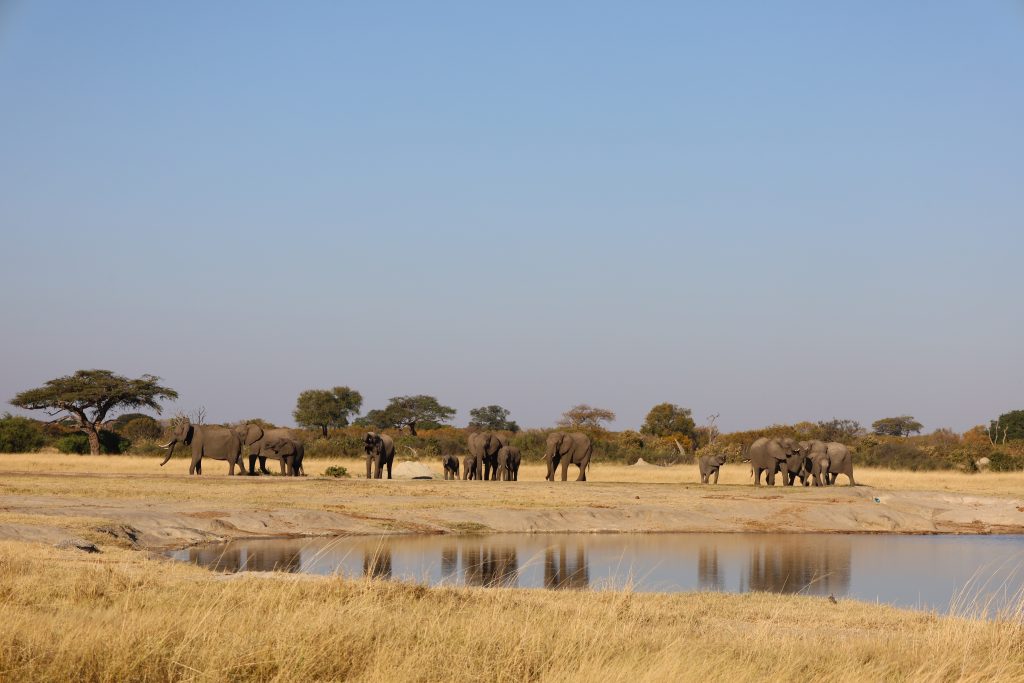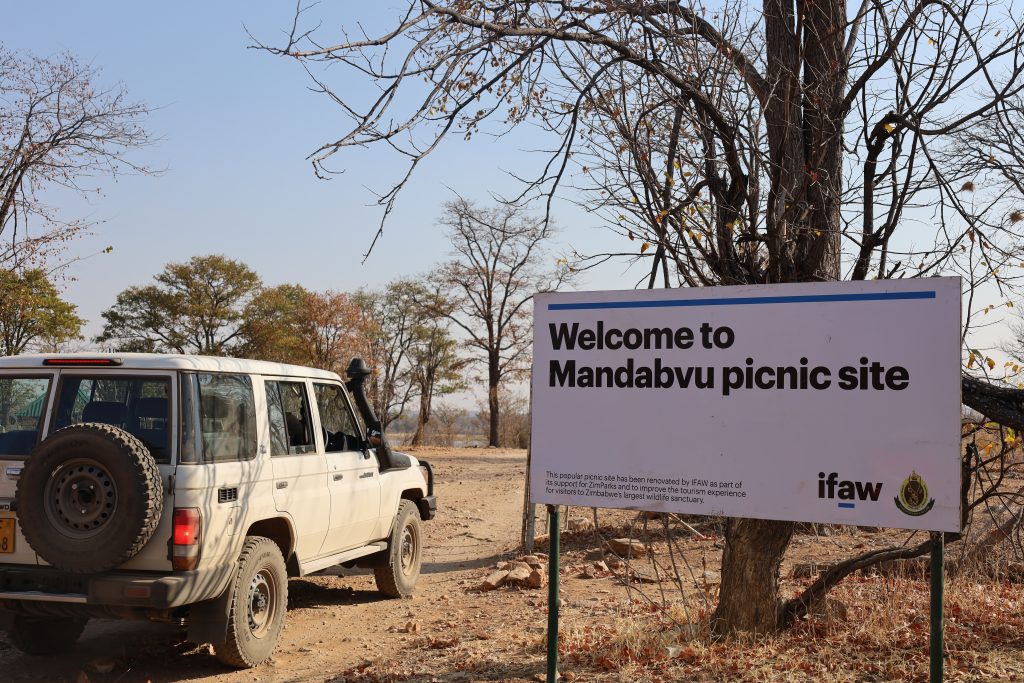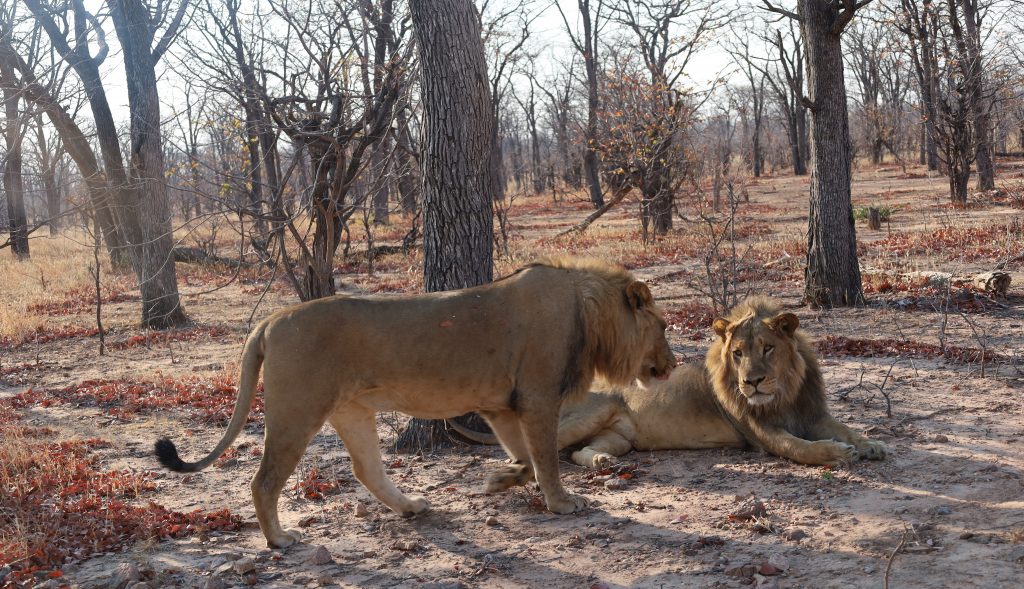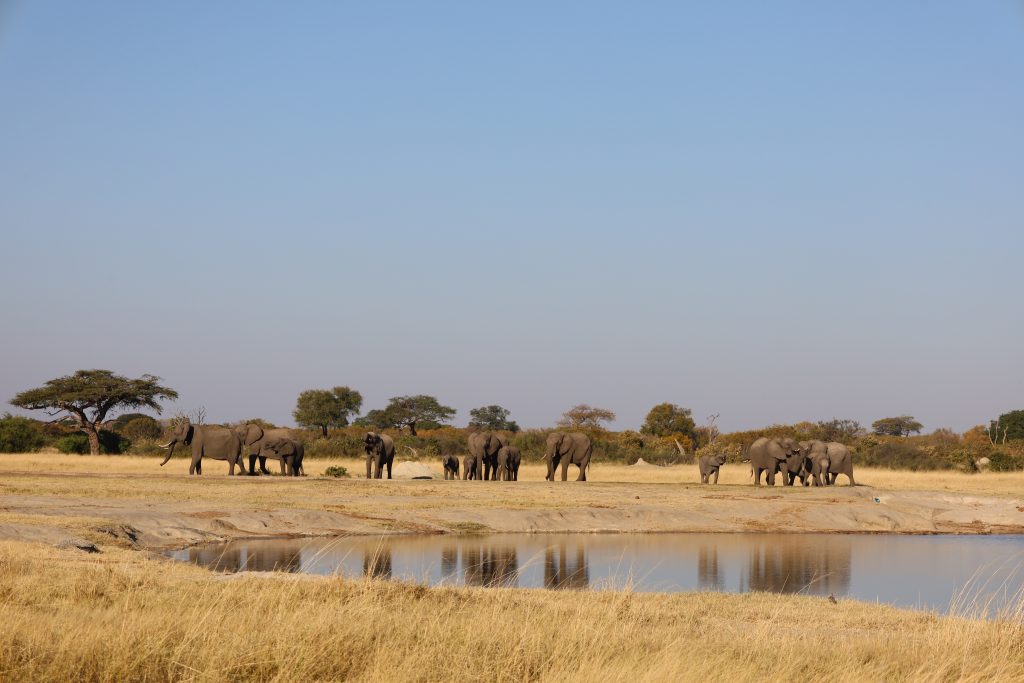Article Luckmore Safuli

As the heat baked the earth on a typical post-winter Hwange afternoon, a group of tourists leisurely sip wine from their glasses while gazing at a spectacular trooping of wild animals converging for a soothing drink.
The idyllic outback, Mandabvu Camp, is situated in a specific location of Zimbabwe’s iconic national park that is teeming with a wide variety of animals and provides the most memorable safari experience imaginable.
The picturesque campsite is on this day playing host to, among others, four South African Safari enthusiasts encompassing a small bonfire on which beef and pork chops are roasting.
They are enthusiastically reminiscing on an extremely adventurous morning game drive they had undertaken.
Holding a half-full wine glass each, the four first time Hwange vacationers from Hermanus – a seaside town southeast of Cape Town – clearly enjoyed the junket inside the authentically immersive Hwange National Park.
But even as they take time to relax and let the reality of it sink, Hwange’s mesmeric wildlife experience still confronts them.
At the lake below their vantage braai point, an assortment of animals are trooping for a drink, as being delivered by conveyor belt.
The Mandabvu dam has, in recent years been a magnet to the creatures; elephants arriving in numerous separate herds, impalas, lions, zebras, and kudus.

As the trippers enjoy the masterfully crafted De Grendel wine, they observe crocodiles in unusually large numbers moving out of the water and strategically positioning themselves for an easy catch. By their own count, about 80 of the deadly reptiles were sighted at one point.
As we sat to converse with them, behold, a massive herd of thirsty Cape buffalo rushed in for a drink, their hooves raising a cloud of thick dust, in the process unsettling the resident hippos which honk their way back into the shallows. Opportunists like kudus and zebra quickly move in to enjoy the drink while the safe shield of the buffalo lasts.
“You don’t get this sort of experience anywhere on earth,” a mesmerized John Stergianos, a well-travelled safari lover, involuntarily retorts.
“There is a lot of wildlife at this park. It just blew my mind. I did not expect Hwange to be like this,” Stergianos said, attracting nods of approval from his equally overjoyed wife, Tanya.
The four middle-aged South African tourists had arrived at Mandabvu Dam the day before and spent a night at the picnic site, entertained for free by the melodies issuing from the forests.
“Before coming to Hwange, we were told that the park is terrible. But to our surprise, the facilities are fantastic, and there is a lot of game,” said Stergianos.
“We have done almost all of the parks in Africa and for me, Hwange ranks up there among the top three. The animals look calm and happy. It is brilliant,” he added.
But, unbeknown to them, this part of the park has only recently become that magnetic.
The dam was silting and drying before it was upgraded with support from the International Fund for Animal Welfare (IFAW).
For Stergianos, just like many other safari enthusiasts, it feels exciting to be able to travel again after enduring the COVID-19 lockdowns that made international travel impossible.
“It was long overdue. We are planning another trip for next year to bring some friends here because everyone deserves to get this sort of experience in their lifetime,” he said.

Up close and personal with the big cats of Hwange
After a 30-minute chat punctuated with laughter, we left the four adventure seekers to enjoy the Mandabvu tranquillity and to form memories that will forever be engraved in their hearts.
August is arguably the best time to spot game in Hwange National Park. It is around this time when game viewing is at its spectacular best, as vegetation will be thinner.
As we drove from Mandabvu to Masuma picnic site, we were all alert with eagle eyes, ready to pick out camouflaged animals.
“Lions! “shouted the driver as he brought the 4×4 vehicle to a sudden halt.
For a moment, there was complete silence in the car. Just by the roadside, two young male lions were lying down, most probably outcasts of a territorial pride out here to bid their time and prepare to one day return and claim the pride as a formidable coalition.
Sighting these elusive top predators in their true natural habitat is always a great experience.
Suddenly, one of the lions got to its feet and leisurely strolled away, but not going anywhere too far. Only about 20 meters off, it lay on the dry grass as if to say, “dare me”.
We spent a good ten minutes watching the two animals, which were completely undisturbed by our presence.
At Masuma Camp, we saw large herds of elephants congregating at the popular waterhole for a drink. The small yet beautiful reservoir attracts hundreds of elephants and offers an opportunity to witness a wide spectrum of wildlife species.
Ablution facilities and other related camping infrastructure at the camp recently underwent a major upgrade under the IFAW-ZimParks partnership.
Hwange post-COVID resurgence
Eager to reconnect with Zimbabwe’s largest wildlife reserve and to experience the authentic African safari, international tourists are flocking back to the iconic Hwange National Park, sparking a gradual post-COVID tourism resurgence.
After tumbling to as low as 10,000 visitors per annum, entries into the 14,600km² Hwange National Park are on an upward trajectory, with more than 30,000 entries recorded in 2022, according to ZimParks.
“It is exciting times for destination Hwange. We are witnessing a gradual resurgence in terms of arrivals. Nature lovers keen to experience the authentic African safari are coming back in droves,” said Loveness Kudiwa, ZimParks Tourism Manager based at Hwange Main Camp.
Tourism arrivals for the period January-July 2023 stood at 18,976 compared to 11, 258 during the same period in 2022.
According to Kudiwa, the post-COVID resurgence has also seen a new trend – the emergence of a more conscious traveller and preference for camping as well as wild spaces.
“It is quite evident that post-COVID-19 travellers are keen to avoid crowded spaces and are seeking exclusive nature-based tourism. This is a welcome development for a destination like Hwange, which offers an authentic life-enriching safari experience,” she added.
The upsurge in tourist traffic into Hwange comes at a time, Zimbabwe, which is targeting to grow the tourism sector into a US$5-billion-dollar industry by 2025, registered an impressive 50% growth in tourist arrivals during the first six months of 2023.
Arrivals into destination Zimbabwe stood at 529,078 while earnings rose by 16% to US$397,7 million compared to the same period in 2022, according to figures from the state-owned tourism marketing agency, Zimbabwe Tourism Authority (ZTA).
Creating an environment for sustained tourism recovery
Thanks to the conservation efforts under the IFAW-ZimParks partnership, the pristine park – home to more than 45,000 elephants and other 100 mammal species – is in good shape, with some of the tourism facilities in and around the park undergoing much-needed upgrades.
Biodiversity conservation initiatives under the value-driven partnership have enhanced the persistence of elephants and other wildlife species.
“Substantial resources have been channelled towards tourism development, and we can overly grateful to our partner, IFAW, for the ongoing efforts to unlock the tourism potential of Hwange,” said Kudiwa.
A tourism executive based in Hwange, James Kuwana, attributed the resurgence to new tourism investment, impressive conservation efforts, and FastJet Zimbabwe’s recent introduction of direct flights into the destination.
“There is increased publicity about Hwange National Park, and we have seen a lot of developments and a surge in tourism investments. Connectivity has also improved with the coming in of FastJet and ExecutiveAir,” said Kuwana.
“Completion of the multi-million dollar Gwayi-Shangani Dam close to Hwange National Park will be a serious game changer. You are looking at other water-related activities being offered by this destination in addition to the game-viewing,” he added.

